Zero-click results have become an almost expected feature of how users interact with search engines today. They give users answers directly on the search results page, essentially nullifying any need to click through to a website.
Now more than ever, people are anticipating Google to give them succinct answers to common questions. This is a huge deal for SEOs and paid media buyers because it changes what inbound digital marketing success looks like.
In this piece, we’ll explore some recent statistics on zero-click searches and discuss how businesses ought to adapt their SEO strategies to align with a zero-click search climate.
Key Highlights
- Zero-click searches now dominate, with 60% of Google searches ending without users clicking through to external websites.
- Featured snippets and direct answer boxes are crucial for capturing visibility in an increasingly zero-click search environment.
- Mobile devices drive zero-click searches, emphasizing the need for content optimized for voice search and mobile SERPs.
- Businesses must focus on structured data and user intent to maintain brand visibility in the face of declining organic traffic.
What Are Zero-Click Searches?
Zero-click searches are results that provide immediate answers directly on the search engine results page. The object is to provide the most direct answer to a user’s query without requiring them to click through to external websites.

Search engines like Google are steering hard into this new model of delivering information to users in an attempt to add even more value to users in less time.
So far, in 2024, almost 60% of searches on Google end without users clicking through to an external site. These zero-click searches encompass both no-click searches, which display answers directly, and low-click searches, which allow users to act within Google’s ecosystem.
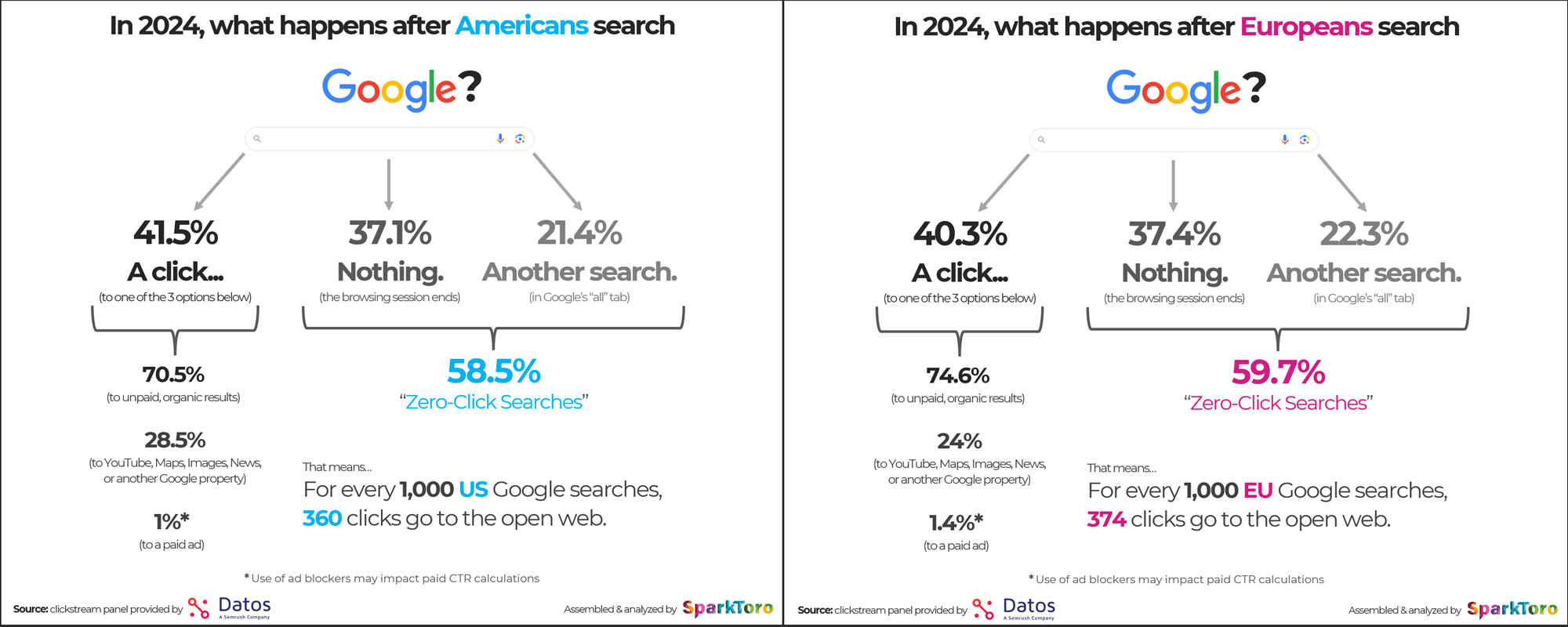
Source: SparkToro
Key Takeaway:
Key Elements of Zero-Click Searches
Zero-click searches provide immediate and mostly comprehensive answers on the Google SERP. They’re usually the first thing a searcher will see, and their intent is to directly address the query in the most direct way possible. To effectively capture this traffic, it is essential to focus on user intent when refining keyword strategies.
Features of zero-click searches include knowledge panels, direct answer boxes, and featured snippets. Each of these items plays a critical role in how information is presented and consumed directly on the search results page.
Let’s take a closer look at each one now.
1) Knowledge Panels
Knowledge panels summarize key information about entities and often appear on the right side of search results. These panels might include facts, Google images, links, and other relevant details, providing a comprehensive overview of the searched topic.
For example, a search for a well-known figure or organization will likely yield a knowledge panel with details sourced from authoritative sites.
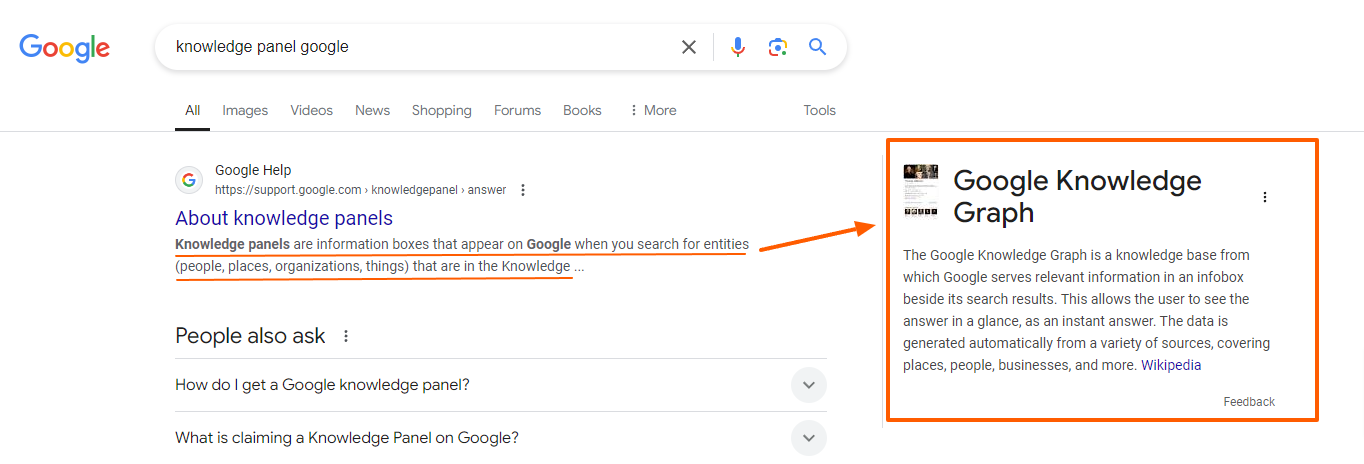
Knowledge panels provide direct answers from authoritative sources, significantly influencing how users interact with Google results. Offering quick and reliable information reduces the need for users to click through additional websites, satisfying their queries immediately.
2) Direct Answer Boxes
Direct answer boxes are a Google SERP feature at the top of search results that provides quick answers without requiring users to click a link. These boxes deliver clear answers to simple questions directly on the SERP, answering the user’s query instantly.
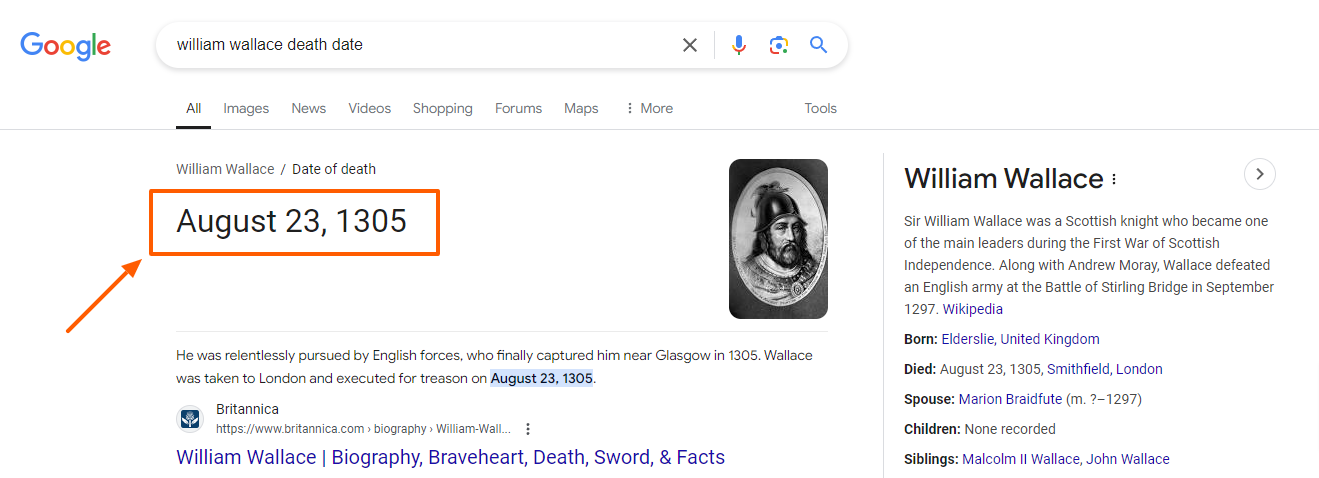
For instance, queries about the weather, stock prices, or simple factual information are often answered directly in these boxes.
Direct answers usually revolve around commonly verified facts and estimations, such as:
- Dictionary references
- Weather forecasts
- Math calculations
- Unit conversions
- Sports matchups, dates, and scores
- Fast facts
Users rarely click on traditional search results when a direct answer box is present because the question is usually direct, and the answer is simple. This Google SERP feature ensures that users receive concise and relevant responses, which often satisfy their search intent without the need for further exploration.
3) Featured Snippets
Featured snippets provide concise answers at the top of search engine results, facilitating zero-click searches. These snippets pull information directly from web pages, presenting it prominently on the SERP.
This placement often leads users to find the answers they need without clicking through to the actual website, altering traditional engagement patterns.

Since featured snippets dominate search results, optimizing content for them becomes essential for maintaining visibility in the SERP. Making sure your content is structured to answer common queries clearly and concisely can increase your chances of being featured in these snippets.
Key Takeaway:
How Zero-Click Searches Impact SEO Strategy
The higher percentage of zero-click searches has profound implications for traditional SEO strategies. The usual metrics, like sessions, may become less effective for gauging SEO success in a zero-click search environment.
Instead, businesses need to focus on metrics like impressions and search position to better understand their visibility on search engine results pages.
Continuous adaptation to changing search engine algorithms is crucial for businesses in the context of zero-click searches. Identifying keywords that commonly result in zero-click results can better inform SEO strategy.
After that, you can implement those keywords into your content to increase the chance Google will highlight your content as one of the three formats mentioned above.
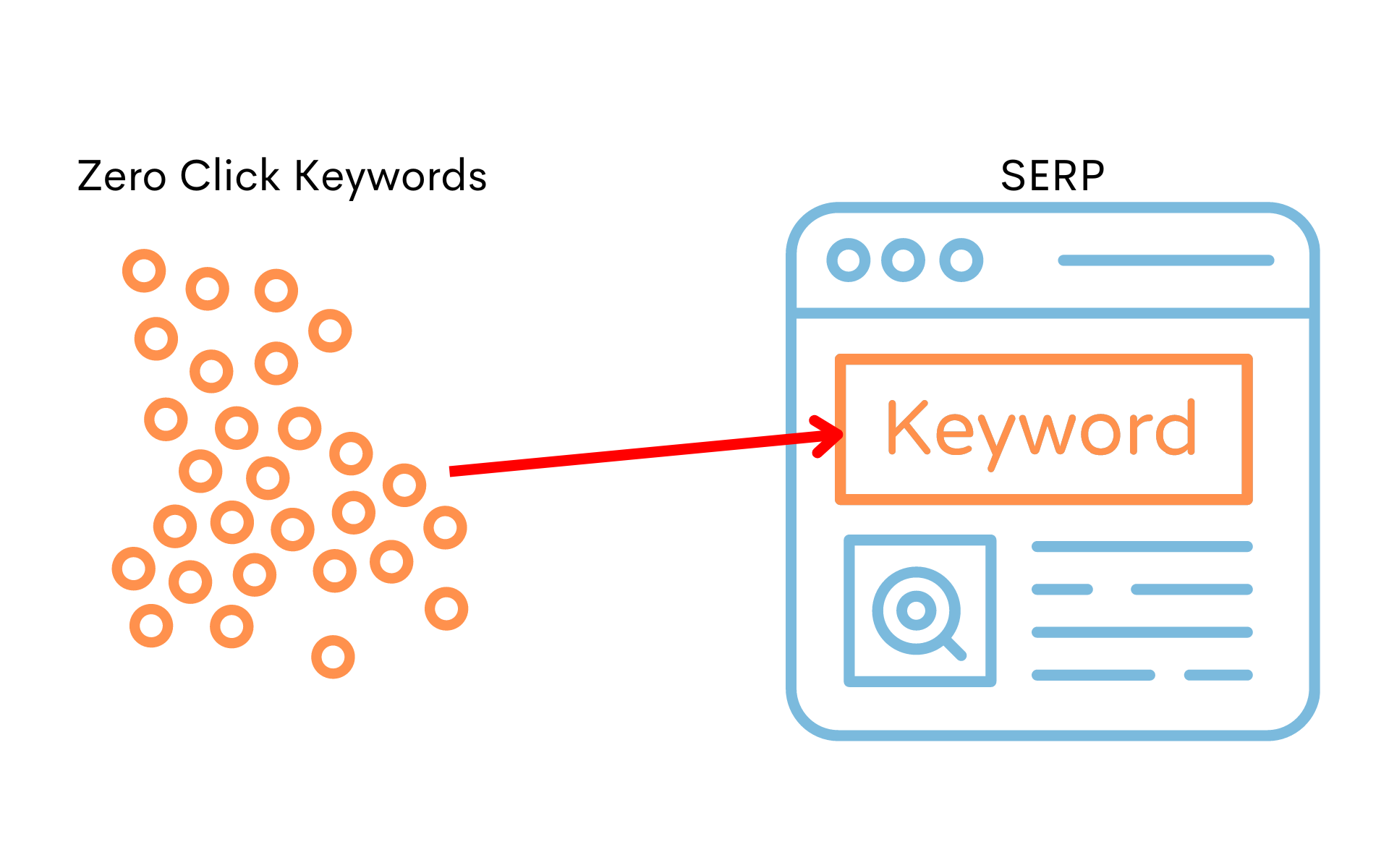
For instance, achieving a featured snippet can enhance visibility for lower-ranked websites, potentially increasing their impressions and organic traffic.
Businesses featured in zero-click searches can experience increased organic traffic by attracting users seeking quick answers.
Although these users may not always click through to the website, the enhanced visibility can still drive significant brand awareness and cause users to recall your brand when they’re ready to engage with your brand.
At the end of the day, Google wants to keep users and content providers happy with the platform. In doing so, it will create opportunities for website owners to highlight their content, but on Google’s turf, not the websites themselves.
It’s a not-so-subtle way of controlling how users see and process information in their searches.
Key Takeaway:
2024 Zero-Click Search Trends Worth Knowing
Zero-click searches started popping up in 2019, but they’ve seen a big jump in the last year with Google’s new emphasis on cultivating its Search Generative Experience for its users. The odds are that Google is going to double down on bringing direct answers to users through instant results.
- Mobile Searches are Leading the Way: Since 2021, Around 63% of all searches in the US are done on mobile devices. This shows just how much people are relying on their phones for immediate answers, which is a big driver behind the popularization of zero-click features.
- The Search Cycle: Roughly 22% of searches, whether on mobile or desktop, lead to another search. The pattern here suggests that many people don’t find what they’re looking for right away, prompting them to keep searching.
- Increased Competition for Featured Snippets: Featured snippets offer prime visibility, making them a key target for companies looking to stand out in search results. As zero-click searches increase, businesses fiercely compete to secure those valuable featured snippets.
- Growth of AI Overviews: By June 2024, AI Overviews were appearing in 12.7% of Google search results in the US. This data point is only set to keep rising beyond 2024, which is indicative of how users want to consume information. It’s implied even further when you factor in how often people prefer to go directly to AI chatbots for their information over search engines.
Currently, these are just observations of behavioral patterns, but they signal a more widespread preference for how users want to consume information. That makes it vital that businesses reconsider how to present their value offer to their audience on search engines.
Challenges Posed by Zero-Click Searches
Zero-click searches can lead to significant challenges for businesses, the most notable being:
- Decrease in Organic Traffic: Users finding information directly on the search results page reduces the likelihood of clicks through to individual websites, leading to a decline in organic traffic.
- Impact on Lead Generation and Conversions: With Google creating a space that drives fewer clicks to websites, businesses may see a decrease in lead generation opportunities and conversion rates, affecting overall sales and growth.
- Reduced User Engagement: Zero-click searches often result in lower engagement metrics, such as time on site and page views, as users no longer need to visit the website to get the information they seek.
- Loss of Control Over User Interaction: Businesses lose some control over how users interact with their content, making it more challenging to build relationships and encourage deeper engagement.
- Pressure to Innovate SEO Strategies: To thrive in an environment dominated by zero-click searches, businesses must continually innovate and adapt their SEO strategies to maintain visibility and engagement.
- Increased Competition for Featured Snippets: As zero-click searches rely heavily on featured snippets, the competition for these valuable placements becomes more intense, requiring higher-quality and more strategically optimized content.
Key Takeaway:
But zero-click searches are not without some boons, either.
Benefits of Zero-Click Searches
Despite the challenges, zero-click searches offer significant benefits for businesses.
Achieving a featured snippet position can enhance brand visibility, showcasing the business as a trusted information source even if it does not result in direct website traffic. This visibility can improve brand reputation and establish the business as an authority in its field.
Zero-click experiences also improve user satisfaction by providing immediate responses to queries. This enhanced user engagement can lead to higher conversion rates, as users perceive the brand as an authoritative and reliable source of information. Optimizing for zero-click searches can thus lead to greater user engagement and more pleasant interactions with search results.
Key Takeaway:
Optimizing Content for Zero-Click Searches
Controlling the effects of zero-click searches involves employing a combination of strategies. Improving content readability by breaking it up into short sections can appeal to both users and search engines.
Strategies such as capturing featured snippets, utilizing structured data, optimizing for specific queries, and creating user-centric content are essential for enhancing visibility and engagement.
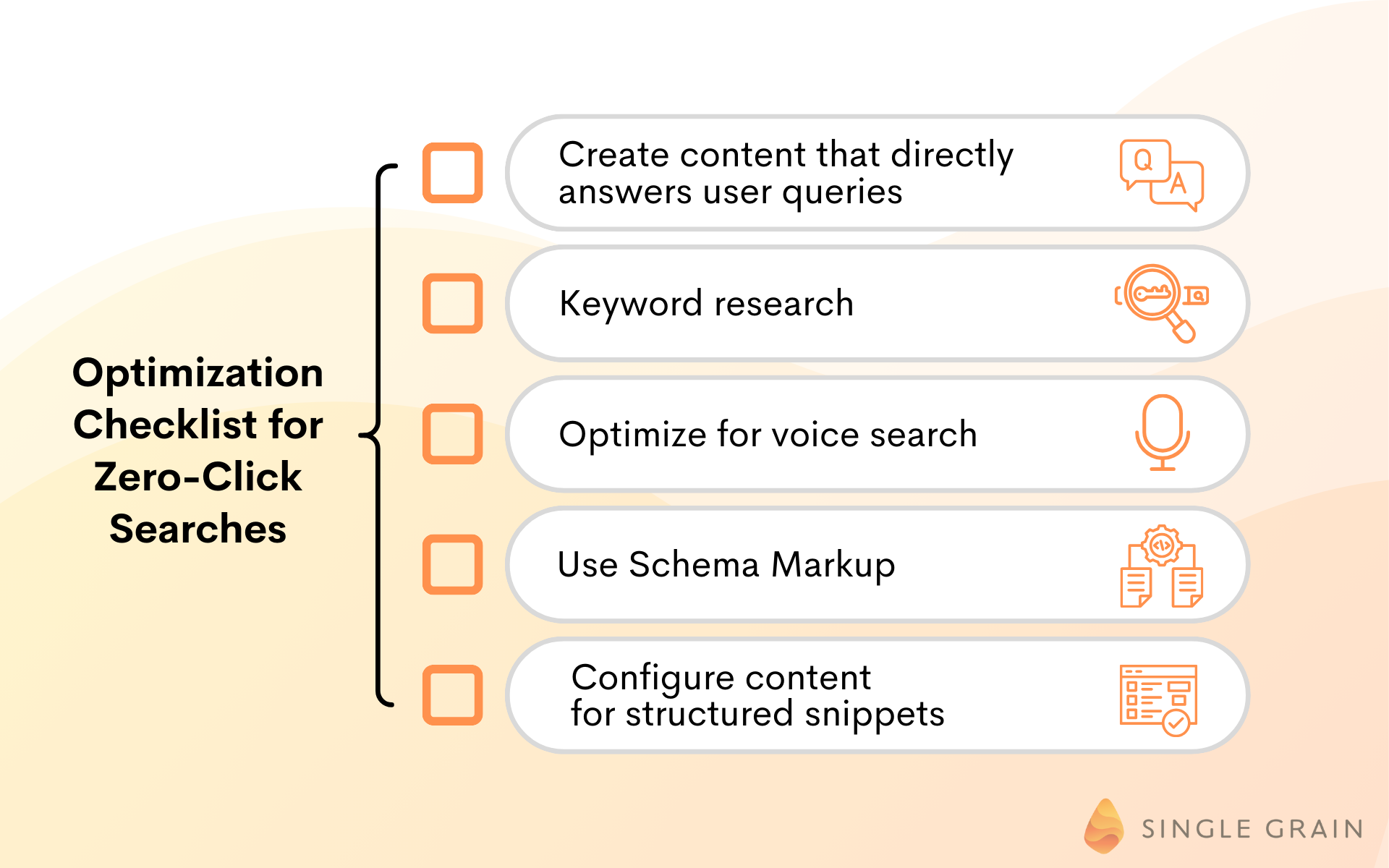
Let’s go through the key areas to focus on for optimizing toward zero-click searches now.
1) Create Content That Directly Answers User Queries
Creating content that directly answers user queries is crucial for capturing zero-click traffic. This involves anticipating the questions users are likely to ask and providing concise, accurate answers. Incorporating these answers into headings, subheadings, and structured formats like FAQs will likely increase the chances of your content being featured in search results.
2) Conduct Thorough Keyword Research
Evaluating whether a specific keyword triggers SERP features is crucial to understanding its potential impact on zero-click searches. Implementing long-tail keywords and refining search queries to be more specific can help avoid zero-click results and increase organic clicks.
Targeting keywords that trigger local pack, featured snippets, and People Also Ask (PAA) boxes can enhance clicks and brand awareness. Adapting keyword strategies to include question-based keywords can further improve visibility in zero-click results, ensuring that content is optimized to meet users’ needs directly on the SERPs.
3) Optimize for Voice Search
With the increasing use of voice-activated devices, voice search optimization is essential for zero-click strategies. Voice searches are often conversational and phrased as questions, so tailoring your content to match these natural language queries is key. Ensure your content includes clear, concise answers to common voice search queries, which can help your content appear in voice search results and featured snippets.
4) Configure Content for Structured Snippets
Structured snippets are a key component of zero-click searches. Configuring your content to be eligible for these snippets involves organizing your information in a way that is easily digestible by search engines. This includes using bullet points, numbered lists, and clearly defined sections that directly address common user queries.
5) Use Schema Markup
Implementing schema markup is a powerful way to enhance your content’s visibility in search results. Schema.org provides a structured way to embed and validate metadata in your content, helping search engines better understand and display your information. Proper use of schema markup can increase the chances of your content appearing in rich snippets, which are often the source of zero-click results.
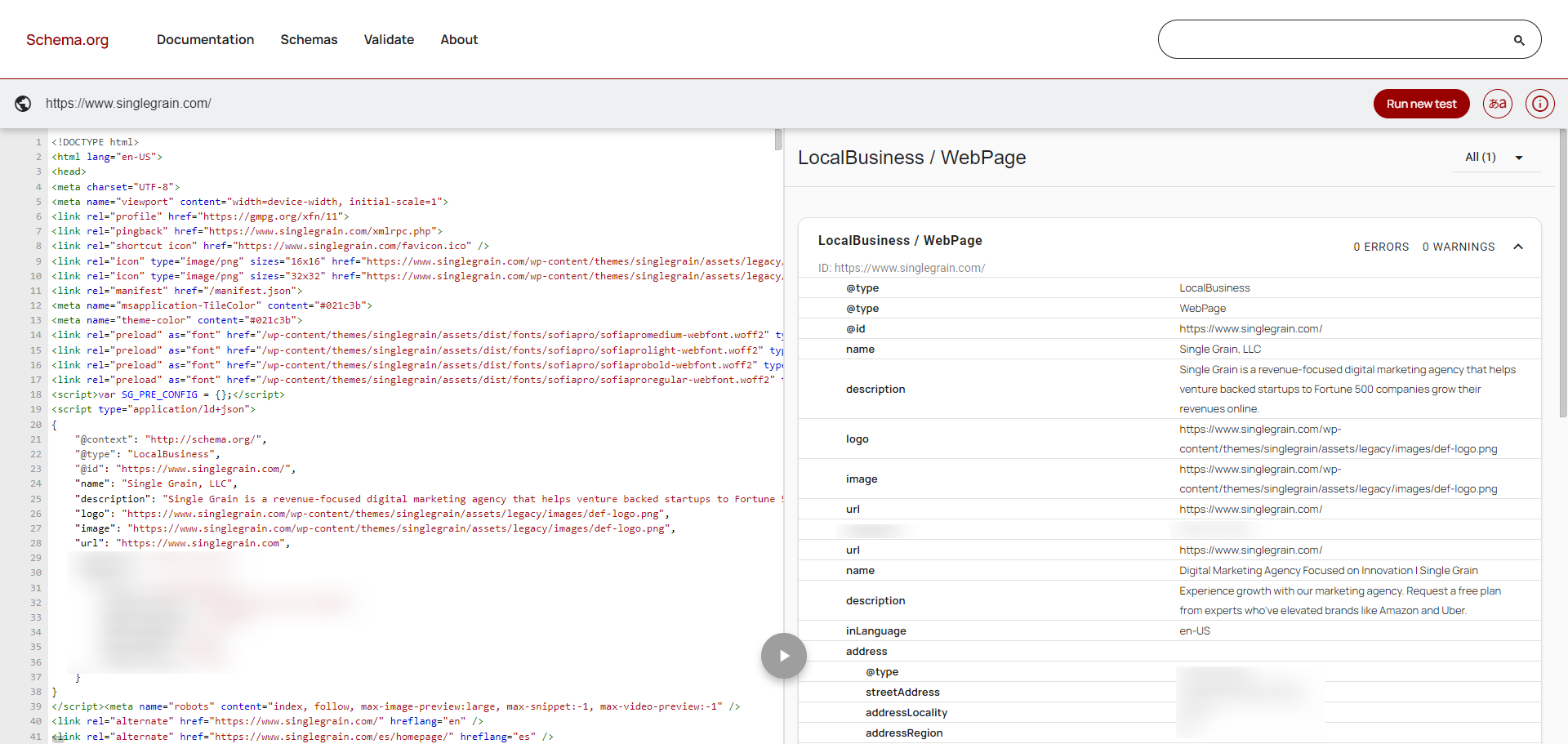
Key Takeaway:
Monitoring Performance and Making Adjustments
Regularly reviewing website performance metrics helps identify trends that may lead to an increase in zero-click searches. Monitoring performance enables businesses to make informed adjustments to their SEO strategies, focusing on metrics like click-through rates and user engagement to understand the impact of zero-click searches.
Adjustments to SEO strategies should be based on performance analytics, ensuring that businesses remain agile and responsive to changes in user behavior. This continuous monitoring and adjustment process is essential for optimizing SEO performance in the context of zero-click searches.
Key Takeaway:
Last Thoughts on Optimizing Zero-Click Searches SEO in 2024
Zero-click searches represent a significant shift in how users interact with search engines. This trend requires businesses to rethink their SEO strategies, focusing on visibility, engagement, and user satisfaction.
As the way people find their information continues to mold, staying ahead of trends like zero-click searches is crucial. By adjusting your perspective and approach to SEO , your businesses can remain competitive and relevant online.
If you’re ready to level up your zero-click visibility, Single Grain’s SEO experts can help!👇
Recommended Video
For more insights and lessons about marketing, check out our Marketing School podcast on YouTube.
Frequently Asked Questions
-
What are zero-click searches?
Zero-click searches refer to queries that deliver immediate answers directly on search result pages, effectively addressing users’ informational needs without necessitating any clicks to external sites.
-
How do zero-click searches affect SEO strategy?
Zero-click searches require businesses to adjust their SEO strategies by prioritizing new metrics like impressions and search positions, while incorporating question-based keywords to enhance visibility in search results.
-
What are some key features of zero-click searches?
Zero-click searches are characterized by knowledge panels, direct answer boxes, and featured snippets, which allow users to access information directly on the SERP without needing to click through to additional links. This enhances user experience by providing immediate answers.
-
What challenges do zero-click searches pose for businesses?
Zero-click searches pose significant challenges for businesses by decreasing organic traffic, which ultimately impacts lead generation and conversions. Additionally, they can diminish engagement metrics and reduce brand visibility, as users may bypass the business’s website entirely.
-
How can businesses optimize content for zero-click searches?
To optimize content for zero-click searches, businesses should focus on capturing featured snippets, implementing structured data, and producing user-centric content that clearly addresses common queries. This approach enhances visibility and engages users effectively.



